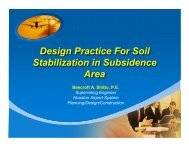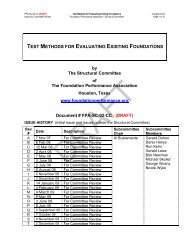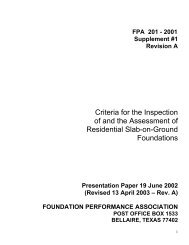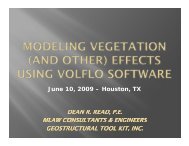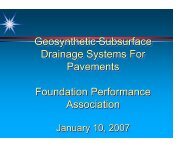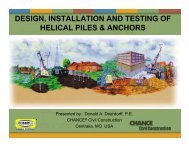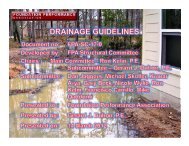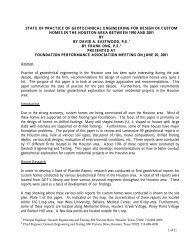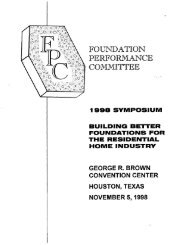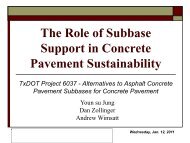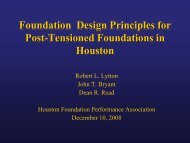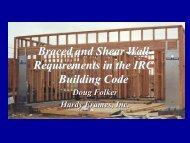Soil-Structure Interaction Seminar - Foundation Performance ...
Soil-Structure Interaction Seminar - Foundation Performance ...
Soil-Structure Interaction Seminar - Foundation Performance ...
You also want an ePaper? Increase the reach of your titles
YUMPU automatically turns print PDFs into web optimized ePapers that Google loves.
Landscaping in North and West Houston, where sandy, non-expansive soils are present, with<br />
flowers and shrubs should not pose a major problem next to the foundations . This condition<br />
assumes that the foundations are designed for saturated soil conditions. Major foundation<br />
problems can occur if the planter areas are saturated as the foundations are not designed for<br />
saturated (perched water table) conditions. The problems can occur in a form of foundation<br />
settlement, brick cracking, etc.<br />
Sprinkler systems can be used in the areas where expansive soils are present, provided the<br />
sprinkler system is placed all around the house to provide a uniform moisture condition<br />
• throughout the year. The use of a sprinkler system in North and West Houston where sandy<br />
soils are present should not pose any problems, provided the foundations are designed for<br />
saturated subsoil conditions with positive drainage away from the structure. The excavations for<br />
the sprinkler system lines, in the areas where expansive soils are present, should be backfilled<br />
with impermeable clays. Bank sands or top soil should not be used as backfill. -Ttrese soils<br />
should be properly compacted to minimize water flow into the excavation trench and seeping<br />
under the foundations, resulting in foundation and structural distress.<br />
The sprinkler system must be checked for leakage at least once a month. Significant foundation<br />
movements can occur if the expansive soils under the foundations are exposed to a source of free<br />
water. The homeowner should also be aware of damage that leaking plumbing or underground<br />
utilities can cause, if they are allowed to continue leaking and providing the expansive soils with<br />
the source of water.<br />
The presence of trees near a residence is considered to be a potential contributing factor to the<br />
foundation distress. Our experience shows that large trees in close proximity to residential<br />
structures can cause foundation and soil settlements. This problem is aggravated by cyclic wet<br />
and dry seasons in the area. <strong>Foundation</strong> damage of residential structures caused by the adjacent<br />
trees indicates that foundation movements of as much as 3- to 4-inches can be experienced in<br />
close proximity to residential foundations.<br />
This condition will be more severe in the periods of extreme drought. Sometimes the root<br />
system of trees such as willow or oak can physically move foundations and walls and cause<br />
considerable structural damage. Root barriers can be installed near the exterior grade beams to<br />
a minimum depth of 36-inches, if trees are left in place in close proximity to foundations. It is<br />
recommended that trees not be planted closer than half the canopy diameter of the mature tree,<br />
typicaJly 20-feet from foundations. Any trees in closer proximity should be thoroughly soaked<br />
at least twice a week during hot summer months, and once a week in periods of low rainfall.<br />
GEOTECH ENGINEERING AND TESTING, INC. -------------·<br />
21



